
Do you dream of adding a touch of history and sophistication to your barware collection? Well, antique glasses may be just what you’re looking for!
But before scouring antique markets and thrift stores, you must know how to tell if a glass is genuinely antique. So, we’ve got you covered!
This article will take you on a journey through time and teach you the insider secrets of identifying antique glassware.
Let’s dive in!
General Tips for Identifying Antique Glass

Identifying antique glass can be challenging, but the following tips can help separate the wheat from the chaff.
Weight
Antique glass tends to be heavier than modern glass objects, and there’s a good reason. Back in the day, glassblowers used thicker glass to create sturdier items, meaning antique glass objects are often thicker and heavier than modern glass.
Imperfections
You may notice bubbles, striations, or variations in color in antique glass objects. If you worry, don’t, as such markings are a good thing and add a point for authenticity.
In the past, glassmaking techniques weren’t quite as advanced as they are now, so these little irregularities were just a normal part of the glassmaking process. But far from flaws, they signify the glass object’s handmade nature, making each piece unique.
Pontil Marks
The pontil mark is an indentation, scar, or rough spot that you’ll find on the base of a piece of glass, and it’s all thanks to the glass maker’s trusty rod, aka the pontil. When the glassmaker detached the pontil from the glass object, it left behind this telltale mark. And here’s the cool part — the roughness of the pontil mark can give us a clue about the age of the glass! Older glass tends to have a rougher pontil mark, while more modern glass often has a smoother, polished mark.
Age Marks
One clue you should look for when determining the age and authenticity of an antique glass object is signs of age. Take a closer look at the base, edges, and other surfaces that usually come into contact with other things and are fragile. If it’s an authentic antique, chances are you’ll see some evidence of use over time.
There could be roughness on the base from years of sitting on a shelf or slight scratches on the edges from being used as a fancy drinking glass. These signs of wear and tear aren’t flaws — they’re like little badges of honor that show the history and character of the object.
Seam Marks
When examining older glass items, you may notice visible seam marks from the mold used in production.
Since, in the past, glassmaking wasn’t quite as sophisticated as it is now, evidence of the manufacturing process in the form of these seam marks is expected.
In contrast, modern glass items are often polished and seamless, making them easier to differentiate from their antique counterparts. So, if you’re searching for an authentic antique glass piece, keep your eyes peeled for those telltale seam marks. These items could be a little rough around the edges, but that’s all part of the charm and history of antique glass!
Colors and Tints

Did you know that antique glass is like a chameleon? Yes, it can change its color over time, and not just because it’s getting old! The materials and techniques used to create it gave it a unique tint or hue.
Take manganese, for example. Back in the 19th century, glassmakers used this material in antique glass production to remove the greenish tint caused by the presence of iron impurities in the glass. Adding manganese to the glass mixture would neutralize the green color, resulting in a clearer glass.
However, when exposed to sunlight or other sources of ultraviolet light, the manganese in the glass creates a chemical reaction that produces a purple or lavender color, adding a unique and beautiful character to the glass. This effect is known as “sun-purpled” or “sun-amethyst” glass and is a prized feature of antique glassware.
Antique glass and modern glassware differ when it comes to colors and hues. Antique glassware was often produced using traditional techniques, resulting in deep, rich colors such as ambers, greens, blues, and reds. The colors were achieved by adding metallic oxides to the glass mixture. Colors like these have a richness that is difficult to replicate in modern glassware.
For instance, the iridescent hues of Tiffany glass, the vivid colors of Loetz glass, and the delicate shades of Galle glass all indicate the period in which they were produced.
On the other hand, modern glassware often features bright, bold colors achieved through chemical dyes and pigments, although these colors often lack the depth and complexity of antique glass.
Maker’s marks
Manufacturers often use these distinctive marks to brand their glass and stand out from the crowd. But here’s the real kicker — by researching these marks, you can figure out who made the glass and when.
So next time you come across an antique glass object, don’t just admire its beauty. Look closely and see if you can spot any maker’s marks or logos. Maybe you’ll uncover a piece of Fenton glass with its iconic “F” mark or a stunning Tiffany glass with the “L.C.T” signature.
Types and Styles of Antique Glass and How to Identify Them
In the antique glassware niche, several popular types and styles of glass objects exist. Knowing how to identify these types and techniques will help determine if the item is antique.
Art Glass
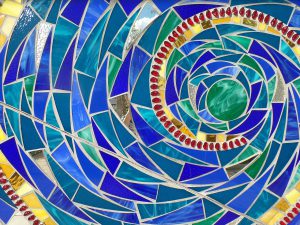
Art glass refers to decorative pieces recognizable by their intricate designs, vibrant colors, and unique patterns. And let us tell you, these pieces are a true feast for the eyes. Produced mainly during the late 19th and early 20th centuries by legendary glass companies like Tiffany, Loetz, Galle, and Daum, art glass is a collector’s dream.
Here are some key things to look for.
First, an iridescent finish that gives art glass its signature shimmer and rainbow-like appearance.
Second, keep your eyes peeled for signatures or marks – these can give you valuable clues about the artist or manufacturer.
And last but not least, check out those unique shapes and patterns that are often featured in art glass. For example, Tiffany Glass is renowned for its delicate lampshades with colorful stained glass panels featuring intricate designs such as flowers, insects, and landscapes.
Loetz glass often features vases with flowing lines, organic shapes, and vibrant colors, achieved through the application of metallic salts.
Galle glass is notable for its cameo glass, which features a thin layer of contrasting colored glass on top of a thicker layer, carved to create intricate designs and patterns.
The Daum family produced glassware in the form of vases, bowls, and lamps, with delicate floral and organic designs achieved through acid-etching and cameo carving techniques.
Depression Glass
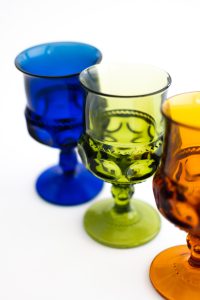
Get ready to take a trip back in time to the era of the Great Depression — and we’re not talking about the stock market crash. Instead, we’re talking about Depression glass!
This antique glassware was produced en masse during the 1929-1939 period and was designed to be both affordable and morale-boosting for consumers. And it definitely did the trick. People loved the bright colors and intricate patterns of Depression glass, and they snapped up these pieces by the millions.
But how do you know if you’ve got the real deal? Here are some key things to look for.
For starters, those visible seam marks from the molds used in production. Depression glass was made in huge quantities, so you may see some telltale marks.
Furthermore, keep an eye out for the glass’s weight. Depression glass is generally thinner and more lightweight than other types of antique glass.
As a final note, check out popular patterns like “American Sweetheart,” “Cameo,” and “Mayfair.” These patterns are very characteristic of Depression glass items.
Fenton Glass
Let’s talk about Fenton Glass, the beloved American glassware company capturing collectors’ attention since 1905. Founded by brothers Frank L. Fenton and John Fenton, this glass company has produced a stunning array of glass creations coveted by collectors worldwide.
So, how do you recognize it?
To begin with, look for the maker’s marks. Fenton Glass often features the company’s logo or other specific markings that indicate the piece’s origin. The logo features a fancy, cursive letter “F” followed by the word “Fenton” in bold, capital letters. The letter is adorned with all kinds of decorative flourishes, making it look like it’s ready to take center stage in a fancy ballroom.
Next, see if you can recognize distinctive patterns. Fenton Glass is known for its incredible range of designs, from the textured Hobnail to the playful Coin Dot to the charming Daisy and Button.
Additionally, search for hand-painted details. Some Fenton Glass pieces are decorated with intricate designs that are lovingly hand-painted by skilled artists, often signed by the artists themselves.
Carnival Glass

Also known as “Iridescent Pressed Glass,” this type of glassware boasts a dazzling, metallic finish that will surely catch your eye. Produced during the early 1900s, carnival glass was often given away as prizes at carnivals and fairs. But don’t let its humble beginnings fool you, as this glassware is a real prize.
To identify carnival glass, watch for its signature iridescent finish, which features a rainbow of colors that seem to dance in the light. Glassmakers achieved the finish through a unique firing process that coated the glass with a thin layer of metallic salts. Carnival glass is also typically made using a pressing technique, resulting in embossed patterns and designs on the surface.
If you’re looking to pinpoint the manufacturer of your carnival glass, famous names like Northwood and Imperial Glass are excellent places to start.
Imperial Glass Company’s logo is simple yet elegant, featuring the words “Imperial Glass” in a stylish font. It’s the kind of logo that just exudes class and sophistication. You can almost hear the clinking of glasses filled with champagne!
Northwood Glass Company’s logos are equally charming, with one featuring the word “NORTHWOOD” in bold block letters with a small, stylized “N” in the center. The other logo is a bit more whimsical, featuring a script-style “N” with the word “Northwood” written in a bold, sans-serif font beneath it.
Milk Glass
Milk glass goes beyond its dairy connotation and encompasses some fascinating antique items. This unique type of glass is easily recognizable by its smooth, opaque appearance in a milky white or off-white hue.
Milk glass has been around for centuries, but it hit its stride in the 19th and 20th centuries when it became a popular material for elegant and versatile designs. To spot milk glass, watch out for intricate molded designs like flowers, fruits, geometric patterns, and any maker’s marks that can help you identify the manufacturer.
Cut Glass
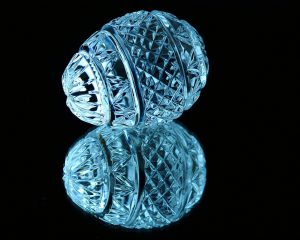
Have you ever marveled at the stunning beauty of cut glass? It’s like looking into a kaleidoscope of mesmerizing patterns and brilliant reflections!
During the American Brilliant Period from 1876-1914, cut glass production in the US was at its peak. This era birthed some of the most intricate and detailed cut glass designs, making it a coveted collector’s item today.
So, how do you spot a cut glass masterpiece?
Look out for its razor-sharp and polished surfaces. The designs often feature geometric patterns like stars, hobstars, and pinwheels that make your eyes dance with delight. And let’s not forget about the weight! Cut glass tends to be heavier due to the thick glass required for the intricate cutting process.
Opalescent Glass
Opalescent glass was trendy in the late 19th and early 20th centuries and crafted by big-name manufacturers like Tiffany and Northwood. So, how do you recognize this elusive glass?
First, look for that milky, translucent appearance with its subtle play of colors.
Next, be on the lookout for unique patterns that some opalescent glass pieces feature, like Fenton’s Coin Spot or Northwood’s Leaf and Beads. Fenton’s Coin Spot pattern has a series of raised dots (aka “coin spots”) evenly spaced apart on the surface. The dots can be either clear or opalescent, creating a beautiful contrast against the milky background.
And if you’re more of a nature lover, you’ll want to check Northwood’s Leaf and Beads pattern with intricately designed leaves with a delicate, natural appearance. The pattern also features raised beads that add a touch of elegance and sophistication. Combined, they give depth and texture to the opalescent glass by creating a stunning three-dimensional effect.
Good Learning Resources
You can learn more about antique glass by joining online communities and reading books.
Online communities
Did you know there are legit websites and online groups about antique glass? Check out The Stretch Glass Society (SGS) to learn about antique glass ID and restoration. And if you’re in the UK, visit The Carnival Glass Society.
Books
If you’re into collecting antique glass, “Starting to Collect Antique Glass ” by John Sandon is the perfect place to start your educational journey. And who could be a better guide than John Sandon? He’s a big deal in the antique glass world.
The book is the whole enchilada! It’s got the details on the mesmerizing history of glassmaking, all the delectable details on the different types of glassware, and a boatload of tips and tricks for identifying and collecting antique glass.
As a bonus, you also have many stunning color photos showcasing antique glass pieces that will knock your socks off!
To know the nitty-gritty details of glass history, you must read “Glass: A Short History” by David Whitehouse. This book covers everything from way back in ancient Egypt up to the present day.
And here’s the cherry on top — the author, David Whitehouse, was the director of the Corning Museum of Glass! This man knows more about glassmaking than a crystal glass ball knows about reflections. He’s got the inside scoop and is spilling the beans about it in his book.
From exploring the development of different types of glass to discovering the role of glass in art and architecture and even uncovering the secrets of the modern glass industry. This book has got you covered!
There are tons of jaw-dropping illustrations and photographs of crystal glass objects from throughout history that will leave you in awe.
Have you heard about the ultimate antique glass bible, “American Glass,” by George S. and Helen McKearin? This book is an absolute must-have for anyone obsessed with antique glass and wanting to take their knowledge to the next level.
George S. and Helen McKearin were total OGs in the glass-collecting world, and their expertise shines through in this book. It’s a deep dive into American glassmaking, covering everything from the colonial era to the mid-20th century. And let us tell you, the detailed descriptions and photos of glassware in this book are marvelous, leaving you in awe as you flip through the pages.
And for all you glass geeks out there, this book spills the tea on insider info about glassmaking techniques and factories across the US.
Antique Glass Restoration
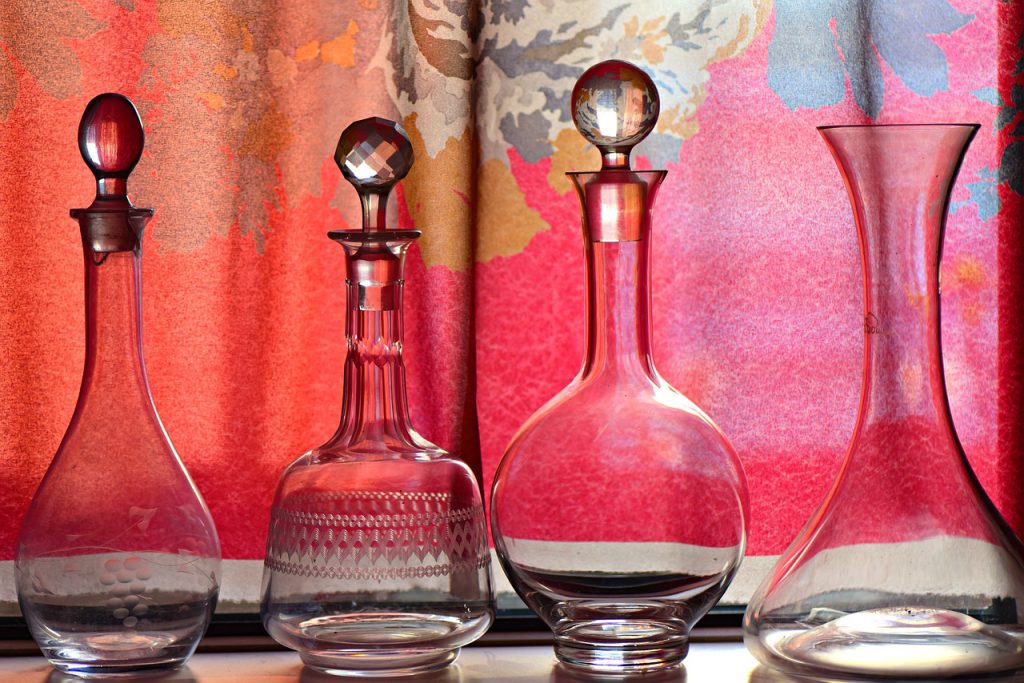
Antique glass restoration is a process of fixing up old and damaged glass objects, like vases and lamps, to make them look as beautiful and functional as they did back in the day. Preserving these treasures is essential so that future generations can appreciate and understand the cultural and historical significance of different periods. The best choice in these situations would be to bring your glassware to a professional restorer.
Before working on your antique glass object, give it a thorough check-up! Common issues include cracks, chips, and missing pieces, but don’t worry — the restorer knows their stuff. They got to have a deep understanding of the materials and techniques used to create the object and the period it came from to ensure the restoration was spot-on.
The restoration process is where the real magic happens! Restorer uses various techniques, like grinding, polishing, and gluing, to ensure your antique glass object looks its best.
However, not all glass is created equal, so the restorer has to use the appropriate materials and adhesives for each type of glass. For example, if you have some cut glass that needs some love, the restorer may whip out a diamond wheel or a felt wheel with a polishing compound to buff out any scratches and make that glass shine as it did back in the day.
For chips or cracks, they typically use a specialized glue designed for glass bonding to fix it. And they can’t be reckless with their choices because one wrong move could lead to even more damage. Patience is key during the process, as the restorer needs to take their time and pay attention to every little detail to make your glass object absolutely stunning.
To Restore or Not to Restore
Some people are all for restoring these items to their former glory. In contrast, others think restoring them takes away from their historical and cultural value.
When deciding whether to restore an antique glass object, you should keep a few questions in mind.
First, what’s the condition of the object? Does it need a minor fix, or is it too damaged?
If the antique glass has minor damage, such as a small crack or chip, it can be fixed using simple techniques such as polishing, cleaning, and minor repairs. If you want to preserve the item, you may even opt out of restoring minor issues. However, if the object is severely damaged, such as a broken or shattered piece, it may require extensive restoration or reconstruction. In these cases, the item’s value is already compromised, and restoration is an approach most take.
Second, what’s the historical significance of the object? Is it a rare piece that tells a story about a specific period?
Some antique glassware has historical value, as it may be a rare or unique piece that tells a story about a specific period. In such cases, the restoration process should preserve the original character and integrity of the piece. For example, if a stained-glass window from a historical church has cracks or missing pieces, it may be better to repair or replace only the damaged areas rather than fixing the entire window.
And lastly, what do you value more – preserving history or having a beautiful display piece? It’s a tough call, but one that you must make.
Glass Care 101
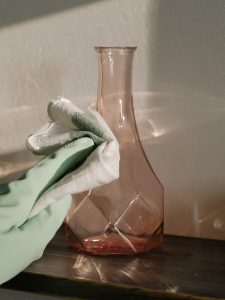
Let’s discuss how to keep your antique glass objects looking their best! Rule number one: Handle with care. These delicate objects break easily, so hold them gently and avoid any sudden movements or impacts.
And always use two hands when picking up an object — we don’t want any accidents, do we?
Next up, regular cleaning is vital. But don’t just grab any old cleaner, as harsh chemicals and abrasive cleaners can damage the glass. Instead, opt for a gentle glass cleaner or mix up some water and vinegar for a more natural approach. And make sure to use a soft, lint-free cloth to wipe down the object and remove any dust or dirt.
When it comes to storage, it’s essential to do it right. Wrap your antique glass object in acid-free tissue paper or bubble wrap, and store it in a sturdy box or container. And don’t stack things on each other, as this may lead to scratches and chips.
Also, let’s not forget about sunlight and temperature changes. Direct sunlight fades or discolors the antique glass over time, so keep your objects out of the sun. Extreme temperature changes may also cause the glass to crack or break, so avoid placing your objects near any heat sources or in areas with fluctuating temperatures.
By following these tips, you can keep your antique glass objects in tip-top shape for years.
Conclusion
Congratulations, my fellow glass aficionado! You’re now armed with all the tips and tricks you need to identify an antique glass like a pro. From examining the glass texture to scrutinizing the pattern, you have all the tools to separate the real antique glass from the imitators.
So what are you waiting for? Grab your magnifying glass, put on your detective hat, and hit up those flea markets and garage sales with newfound confidence. The thrill of the hunt is waiting for you, with the possibility of discovering a true gem hiding in plain sight.
Remember, the antique glass world is an endless sea of beauty and history waiting to be explored. So go forth and uncover those hidden treasures, and who knows – one day, you’ll become an expert collector with a priceless collection of your own.

Leave a Reply